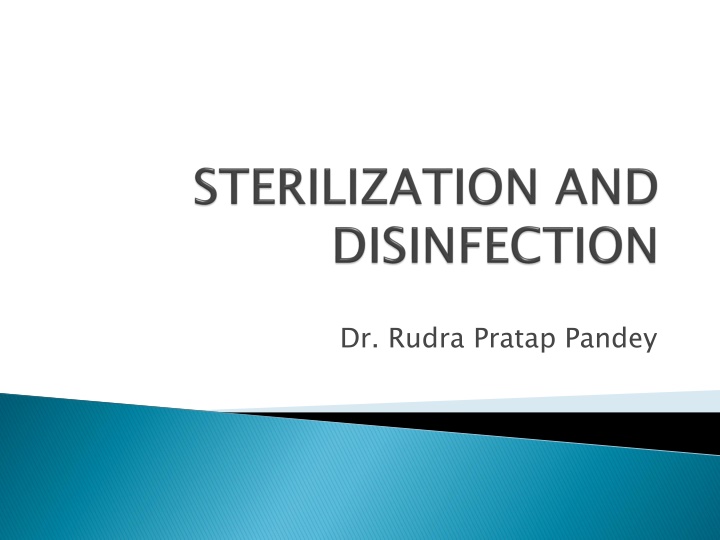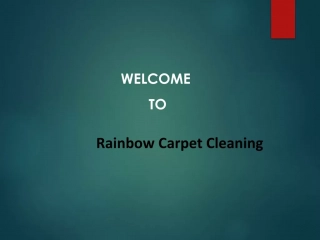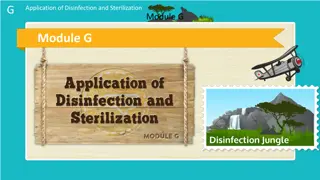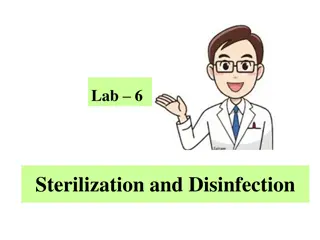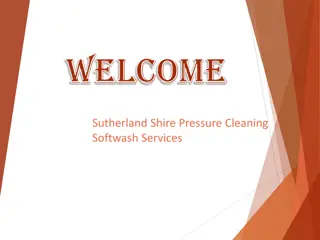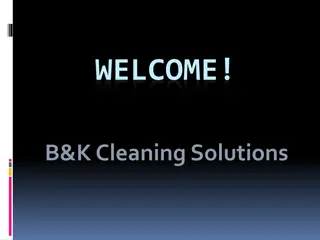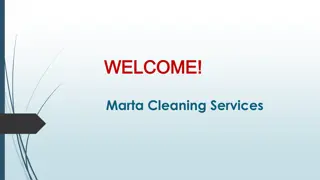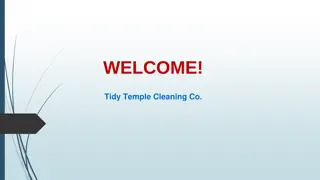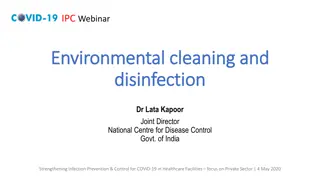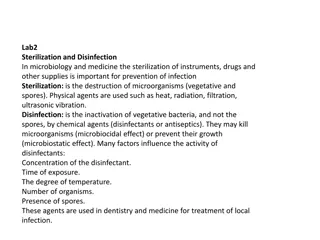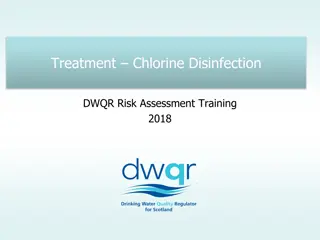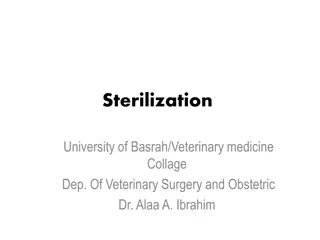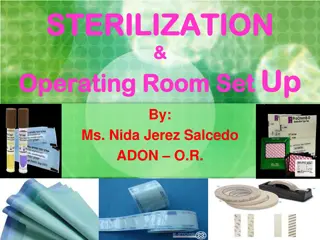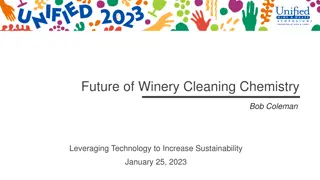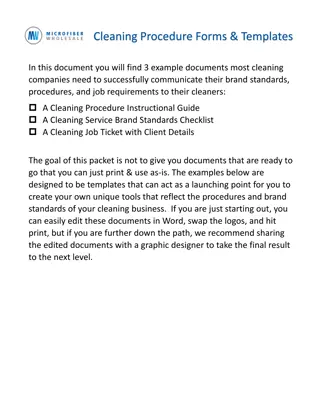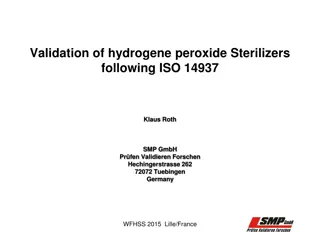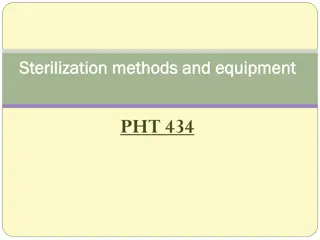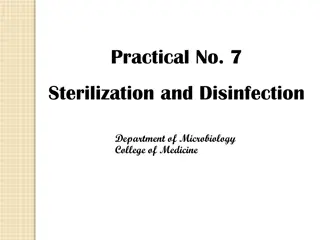Cleaning, Disinfection, and Sterilization
Cleaning, disinfection, and sterilization are crucial processes to eliminate microorganisms and ensure safety. Cleaning removes visible material, disinfection eliminates pathogens, and sterilization destroys all microbial life. Learn about critical objects, levels of disinfection, and the importance of proper decontamination. Remember, critical items require sterilization or high-level disinfection to maintain a safe environment.
Download Presentation

Please find below an Image/Link to download the presentation.
The content on the website is provided AS IS for your information and personal use only. It may not be sold, licensed, or shared on other websites without obtaining consent from the author.If you encounter any issues during the download, it is possible that the publisher has removed the file from their server.
You are allowed to download the files provided on this website for personal or commercial use, subject to the condition that they are used lawfully. All files are the property of their respective owners.
The content on the website is provided AS IS for your information and personal use only. It may not be sold, licensed, or shared on other websites without obtaining consent from the author.
E N D
Presentation Transcript
Cleaning Disinfection Degermination Decontamination Antisepsis Sterilization Asepsis
is the removal of visible organic and inorganic material from objects and surfaces is accomplished manually or mechanically or by using ultrasonic cleaners using water with detergents or enzymatic products.
Disinfection describes a process that eliminates many or all pathogenic microorganisms, except bacterial spores, on inanimate objects usually by liquid chemicals or wet pasteurization. Decontamination removes pathogenic microorganisms from objects so they are safe to handle, use, or discard. Antiseptics are germicides applied to living tissue and skin (degermination) Disinfectants are antimicrobials applied only to inanimate objects.
Disinfectants are not sporicidal. Disinfectants that kill spores with prolonged exposure times (3 12 hours) are called chemical sterilants. high-level disinfectants kill all microorganisms except large numbers of bacterial spores at shorter exposure periods (e.g., 20 minutes for 2% glutaraldehyde). Low-level disinfectants can kill most vegetative bacteria, some fungi, and some viruses in a practical period of time ( 10 minutes). Intermediate-level disinfectants might be cidal for mycobacteria, vegetative bacteria, most viruses, and most fungi but do not kill bacterial spores.
Critical Objects which enter normally sterile tissue or the vascular system and require sterilization Semi critical Objects that contact mucous membranes or non intact skin and require high level disinfection. Non critical Objects that contact intact skin but not mucous membranes, and require low level disinfection
Remember critical items require sterilization or high level disinfection Sterile CRITICAL .. Sterile CRITICAL .. HLD HLD SEMI CRITICAL ILD LLD Decontamination SEMI CRITICAL ILD LLD Decontamination NON CRITICAL .. NON CRITICAL ..
a process that destroys all forms of microbial life is carried out by physical or chemical methods. conveys an absolute meaning! There is nothing like partially or almost sterile. All or None ..Sterile or Contaminated
organic and inorganic load present type and level of microbial contamination concentration of and exposure time to the germicide physical nature of the object (crevices, hinges, and lumen) temperature, pressure, duration (autoclaving) presence of biofilms temperature and pH of the disinfection process relative humidity of the sterilization (ethylene oxide)
Dry heat sterilization flaming, hot air oven, glass bead sterilization Moist heat sterilization boiling, autoclaving, flash steam sterilization Cold or chemical sterilization (gluteraldehyde) Gas sterilization (ethylene diaoxide) Irradiation (ionizing gamma and x rays; non ionizing UV radiation)
Flaming needle/blade over gas flame till red hot. Not practiced except in emergency Hot air oven - metal instruments and glassware. A temperature of 120 C for 8 hours, 140 C for 2.5 hours, 160 C for 1 hour and 180 C for 20-30 minutes is sufficient. Not practiced as sharp edges become blunt. Glass beads when red hot can be used to sterilize scalpel and instrument tips. Used during or between surgeries. Not practiced.
An effective method of sterilization in emergency. Adding 2% sodium carbonate to boiling water helps in destruction of microbial spores. After water starts boiling at 100 C keep the items for minimum15 minutes. Moisture on items is a disadvantage.
Most effective and practiced method. Two types .gravity displacement and high speed prevacuum. Common setting is 30 minutes at 121 0C in a gravity displacement sterilizer or 4 minutes at 132 0C in a prevacuum sterilizer Temperature-pressure-time relationship Gravity displacement steam autoclaves Pre-vacuum autoclaves unwrapped items sterilization) lightly wrapped items heavily wrapped items In field conditions large pressure cooker can be used to steam sterilize the pack. Duration of exposure 45 min 1210C 15psi 15-30 min 132 0C 30psi 3min (flash 132 0C 30psi 8min 132 0C 30psi 10min
Alcohols ethyl, isopropyl, trichlorobutanol Aldehydes formaldehyde, glutaraldehyde Halogens Phenols Surface active agents Metallic salts Gases ethylene oxide, formaldehyde, betapropiolactone.
Wide spectrum of activity Active in the presence of organic matter Effective in acid as well as alkaline media Speedy action High penetrating power Stable Compatible with other antiseptics and disinfectants Should be non corrosive Not cause local irritation or sensitization Not interfere with healing Not be toxic if absorbed into circulation Cheap and easily available Safe and easy to use
Protein coagulation Disruption of cell membrane resulting in exposure, damage or loss of the contents Removal of free sulphydryl groups essential for the functioning of the enzymes Substrate competition by misleading the enzymes necessary for the metabolism of the cells to cause its death.
Ethanol (80% v/v ethyl alcohol) or 2-propanol (60- 70% v/v iso- propyl alcohol) solutions are used to disinfect skin and decontaminate clean surfaces. Spectrum: Effective against fungi, vegetative bacteria, Mycobacterium species and some lipid- containing viruses. Limitation: Not effective against spores, most effective at 70% in water, flammable, swell rubber or harden plastics.
13% v/v formalin is a good decontaminant (but has an irritating odour), 8% v/v formalin in 80% v/v alcohol is effective against vegetative bacteria, spores and viruses. Does not corrode stainless steel. used to preserve specimens, and for destroying anthrax spores in hair and wool. 10% formalin containing 0.5% sodium tetraborate is used to sterilize clean metal instruments. Formaldehyde gas is used to sterilize instruments, heat sensitive catheters and for fumigation of wards and laboratories, clothing, bedding, furniture and surface Paraformaldehyde tablets are used in formalin chambers. Sterilization of contents of the chamber is achieved in 12 hours
Glutaraldehyde available as 2% w/v aqueous solution (alkaline activator 0.3% sodabicarb). Also available in stable glycocomplexed form which does not require addition of alkaline buffer. Stored in air tight containers and away from heat. A 2% glutaraldehyde solution, for at least 10 hours, can be used to sterilize heat labile items. Used for immersion of instruments such as endoscopes, rubber and pvc anesthetic tubes, masks, ET tubes, metal instruments. Glutaraldehyde is known to cause dermatitis and asthma. Less irritating than formaldehyde but should not be used in an area with little ventilation. Glutaraldehyde solutions can be used for up to 14 days. \ Solutions should be replaced any time they become cloudy. 20. Advantages inexpensive good materials compatibility Disadvantages Pungent and irritating odor .Relatively slow mycobactericidal activity Coagulates blood and fix tissues.
inexpensive, broad spectrum chlorine releasing disinfectants of choice against viruses used in a concentration of 0.2-1% hypochlorites are inactivated by organic matter. corrode metals great widespread use as a laboratory disinfectant on surfaces of bench and in hidden spots.
largely replaced the aqueous and tincture forms of iodine due to less staining and irritation Iodophores are chemical complexes with iodine bound to a carrier such as polyvinylpyrolidone (povidone) or ethoxylated nonionic detergents gradually releasing iodine. Commercial PVP in a dilution of 1:2 to 1:100 kills most bacteria including S. aureus. may become contaminated by organisms like pseudomonas widely used for antisepsis of skin, mucosa and wounds.
chlorhexidine gluconate is dissolved in 70% alcohol. effective against Gram positive organisms and HIV. active in ph range 5.5 - 8.0. not recommended as a general disinfectant. not active against sporulating bacteria or non- lipid- containing viruses. incompatible with soap and anionic detergents. savlon (chlorhexidine+cetrimide) is widely used in burns, wounds, as bladder irrigant, for surgical instruments and pre-operative disinfection of skin.
A concentration of 3% w/v generally used for disinfection. Active against a range of microorganisms. Fungi, spores and enteric viruses require higher concentration. Non toxic end-products of decomposition. Not to be used on aluminium, copper, zinc or brass. H2O2 on decomposition liberates free hydroxyl radical which is the active ingredient in the process. H2O2 is applied to disinfect plastic implants and surgical prostheses. Concentrations of hydrogen peroxide from 6% to 25% show promise as chemical sterilants
is a high-level disinfectant containing 0.55% 1,2- benzene dicarboxaldehyde (OPA). OPA solution is a clear, pale-blue liquid with a pH of 7.5. excellent stability over a wide pH range (pH 3 9), is not a known irritant to the eyes and nasal passages, no exposure monitoring needed, has no odor, and doesn t requires activation. OPA stains proteins gray (including unprotected skin) hence extensive rinsing needed As chemical sterilant 0.55% concentration is used
Peracetic, or peroxyacetic, acid is characterized by rapid action against all microorganisms. Special advantages are that it lacks harmful decomposition products (i.e., acetic acid, water, oxygen, hydrogen peroxide), enhances removal of organic material and leaves no residue. It remains effective in the presence of organic matter and is sporicidal even at low temperatures. It can corrode metals. It is considered unstable, when diluted; for example, a 1% solution loses half its strength through hydrolysis in 6 days, whereas 40% peracetic acid loses 1% 2% of its active ingredients per month. Used in 0.35% concentration for disinfection is chemical sterilant with H2O2 (0.08% peracetic acid plus 1.0% hydrogen peroxide and 0.23% peracetic acid plus 7.35% hydrogen peroxide. Mostly used for disinfection and sterilization of hemodialysis units and sometimes endoscopes
The wavelength of UV radiation ranges from 328 nm to 210 nm (3280 A to 2100 A). Its maximum bactericidal effect occurs at 240 280 nm. Mercury vapor lamps emit more than 90% of their radiation at 253.7 nm, which is near the maximum microbicidal activity. Use is limited to airborne microbes and surface microbes Efficacy doubtful as no data support the use of UV lamps in isolation rooms May cause UV-induced skin erythema and kerato- conjunctivitis in hospital patients and staff.
